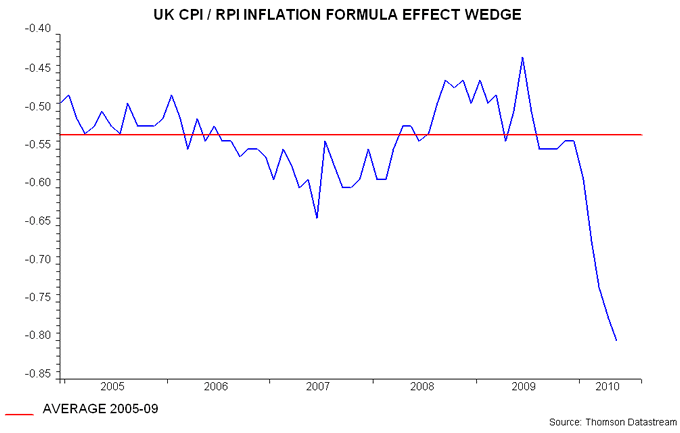UK CPI inflation understates purchasing power erosion
If the consumer price index is to be believed, the volume of spending by the British public on clothing and footwear is nearly three and a half times its level in 1997.
The cash value of spending rose by two-thirds between the first quarters of 1997 and 2010. According to the CPI, however, clothing and footwear prices have fallen by 51% over this period, implying an increase in the volume of spending of 243%.
The national accounts measure of the volume of spending on clothing and footwear, based on retail price rather than CPI methodology, shows a smaller rise, of 130%. This still equates to a solid 6.6% annualised rate of increase. The CPI-based measure suggests that spending volume has grown by 9.9% per annum. Absent evidence of a boom in wardrobe sales, this looks implausible.
This example highlights the significant divergence between CPI and RPI inflation caused by the former's use of geometric rather than arithmetic means to combine price changes of individual items. Geometric means are always lower, with the shortfall increasing with dispersion among components. Proponents of the geometric approach argue that it captures "substitution" between cheaper and more expensive goods as prices changes. The arithmetic mean, however, correctly measures the changing cost of a fixed basket of products.
Clothing and footwear prices rose by 6.3% in the year to June according to the RPI but fell by 1.4% if the CPI is to be believed. The difference subtracted 0.4 percentage points from headline CPI inflation in June. This is larger than the average 0.2 pp effect over the five years to 2009, reflecting a decision this year to use more quotes for each item, with resulting wider price change dispersion further lowering geometric mean inflation relative to the arithmetic mean.
The total "formula effect" wedge between CPI and RPI inflation, incorporating differences in other index components, was 0.8 percentage points in June – see chart.
A central bank's key responsibility is to preserve the real value of money. Consumers on fixed incomes or with fixed savings are understandably sceptical about the "substitution" argument and believe that RPI inflation is a better guide to the erosion of their purchasing power. They have been abandoned by the Bank of England, which has failed to prevent high inflation even on the weaker CPI measure. The coalition government now plans to effect a further transfer of wealth by imposing CPI- rather than RPI-linking on pensioners, benefit recipients and wage-earners.
Failure to protect the purchasing power of money reinforces the incentive to borrow rather than save and invest, thereby preventing necessary economic "rebalancing".

Reader Comments